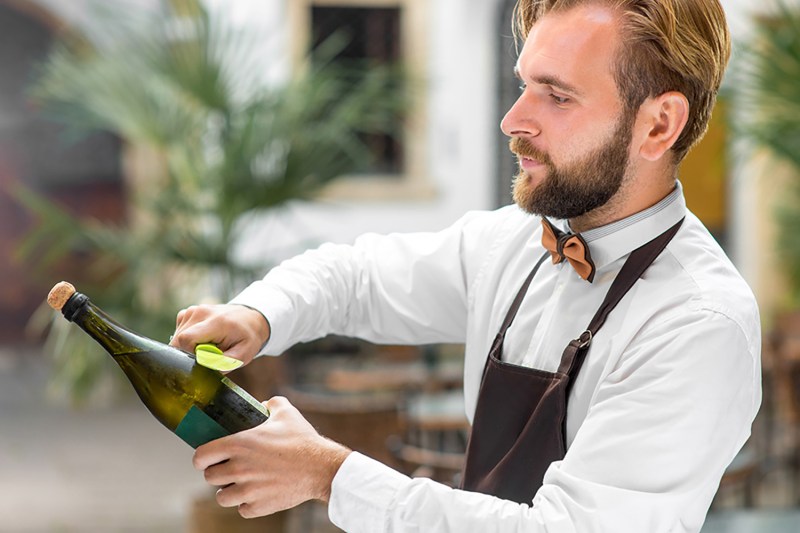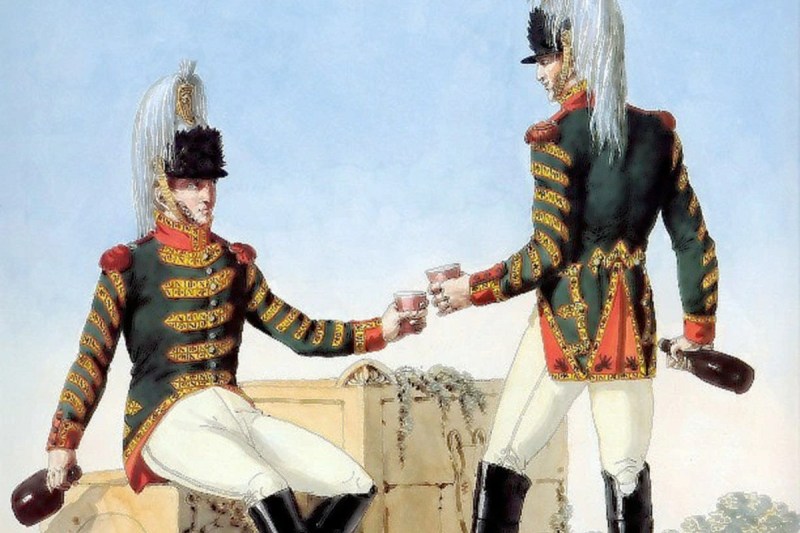Need a new way to impress your friends during this year’s New Year’s Eve party? If there are going to be bottles of sparkling wine present, do we have a badass party trick for you: sabrage. Sabrage is the art of opening a champagne bottle with a saber, the heavy cavalry sword with a curved blade best known for its use by Napoleon Bonaparte’s army in the 1800s.
(Note: For the remainder of the article, we’ll be using the American English spelling of saber, which we used above, compared to the British English spelling of sabre, because ‘Merica.) So without further ado, let’s look at how to saber a bottle of champagne.

The history of sabering champagne
Napoleon was reportedly the first to lop off a bottle of bubbly this way. Old champagne bottles did not have cages over the corks and were kept closed by a cork, some rope, and wax. This made it difficult to open the bottles and — being on horseback and always in a rush — the first emperor of France found it easier and faster to lop off the top of the bottle with a sword.
Sabrage, therefore, became a means of celebrating a victory. Which, if you ask us, is the perfect way of signifying victory. Imagine yourself, high on horseback, saber unsheathed, screaming victory at the top of your lungs before taking a bottle of champagne out of your saddlebag and opening it in the manliest way ever.

How to saber a bottle of champagne
Today we have easier means of popping bottles, but The Manual wanted to learn the skill of sabrage. We had a few questions, like: How difficult is it? Will I cut myself? And do you need a real saber? Unfortunately, we don’t have one — yet — so we asked for some alternatives in that department as well.
G.H. Mumm’s chef de cave — aka cellarmaster for the northern France-based champagne brand — Didier Mariotti says sabrage can be quite simple and safe. In fact, you can use anything from a saber to a knife to a men’s watch.
First things first: “Use a bottle of champagne,” says Mariotti, who suggests avoiding bigger bottles since the glass can be too fragile. It goes without saying that you need to hold the Champagne bottle with your hand at the bottom. Then, tilt the bottle 30-45 degrees to keep too much bubbly from spilling.
Next, find the seam. “On every bottle, you have two opposite lines because it was made with a mold. If you follow a line, it goes up to the neck. You follow this line with the saber or knife, following through with your arm (do not stop at the neck),” Mariotti explains.
Mariotti attests that he has done sabrage with everything, including a saber, a knife, a spoon, and a timepiece.
With a saber, use the sharp side; with a knife, use the dull side. It’s about speed, not strength, Mariotti says: “Do not try and break the neck, but hit properly at its weak spot.” The motion should be fluid and fast. And of course, make sure nobody is in the line of your trajectory.
The pressure in the bottle does the rest of the work, pushing the wine out of the top. If you have small pieces of glass leftover from the sabrage, they will go out too. “Except if you try to break the neck,” Mariotti reemphasizes.
Unlike shucking oysters, mastering the art of sabrage can be achieved on the first go. “If you get the right speed and movement, the first bottle will be perfect,” says Mariotti.
Now … about what utensil to use. Mariotti attests that he has done sabrage with everything, including a saber, a knife, a spoon, and a timepiece. “I’ve tried with a lot of stupid things,” he laughs. “It’s worked all the time since the glass is fragile.”
To saber or not to saber
Julian White, the U.K. ambassador for Confrerie du Sabre d’Or, disagrees, saying only a saber should be used. We asked if a machete was do-able.
“Read the word! The clue is in the name sabrage! A saber is used,” White says, who received his ambassadorship to Paris in 1999 and was made a Chevalier-Sabreur, a title bestowed only to those who have completed five years of training and perfected the art of sabering a magnum of champagne.
There’s a difference between lopping off the neck and doing it with class and style.
While White agrees that “it is simple and anyone can do it,” in the world of high-profile sabrage, there’s a difference between lopping off the neck and doing it with class and style, and the latter is always done with a sword.
If you want to practice sabrage in the way of tradition, opening a bottle of champagne with a saber is the easiest way. However, Mariotti says all you really need is an object “that has a soft enough surface to hit the weak part … a saber is proper, but you can sneak out of the mold and find fun, energetic ways to enjoy champagne.”
Once the bottle is open, Mariotti recommends playing with the taste by pouring yourself three glasses: One in a flute, one in a white wine glass, and another in a red wine glass. The champagne will be totally different in each one. Then, by all means, put away your saber.
Do you want to try opening a bottle of bubbly with a saber? Berkel, a company known for their knives and slicers, recently debuted a saber specifically made for opening champagne. The saber comes in three styles — Deer, Black Buffalo, and Blonde Buffalo — and cost $389 for the Buffalo iterations or $499 for the Deer version. You can order your own Berkel Saber here.


